Basic Dungeons & Dragons
| This article or section is about something oldschool - and awesome. Make sure your rose-tinted glasses are on nice and tight, and prepare for a lovely walk down nostalgia lane. |
While Gygax was busy making "Advanced" Dungeons & Dragons, a doctor named John Eric Holmes worked on the original rules (plus Supplement I) with the intention of producing a single volume as an introduction for beginners. Holmes' Basic D&D (1977) was to be followed (i.e., split out, and abrogated) in 1981 by Basic and Expert D&D, edited by Tom Moldvay. Between 1983 and 1985, Frank Mentzer redid Moldvay's Sets to scale up to the BECMI series.
While often derided as "Kiddie D&D", sales of the basic version exceeded those of the Advanced version for a few years. The system was a stepped system, meaning you could just buy the Basic book at a relatively low cost (around $7) and if you wanted to advance your character past level 3, you could buy the Expert books and so on. Each book in each set was available separately.
Frank Mentzer BECMI
A few themes in Moldvay / Mentzer as against the (Holmes-compatible) Monster Manual and ensuing AD&D are evident.
None of these guys liked Gotcha Monsters. There's no Roper in the Sets; and when Zeb Cook will moot the Dusanu and the Geonid, Mentzer will give the HELL NO to any of that. All this, despite that they let in that probably-originally-a-typo Thoul.
Mentzer further deemed Demons as Mature content. Moldvay chained up a demon in X2: Castle Amber, but Mentzer didn't allow this thing into his Expert edition - nor in any succeeding Sets until the Immortals. Mentzer will reserve this niche for ever-more-powerful undead like the Nightshade.
Authors will continue to resist these design-decisions. We did get the dusanu, the geonid, and even the roper in various modules. And Alphaks manifests as a Balrog in M1: Into The Maelstrom.
Also, Mentzer (initially) didn't think that religion should depend on what specific gods are worshipped - beyond the obvious, that "Chaotic" gods will have wicked clerics. This was a stark break from Gygax, who had insisted (in Deities & Demigods) that weak gods will have weak clerics. For Gygax, that was a role-playing opportunity for an ambitious cleric of a weaker god to raise that god's profile.
Mentzer may have come around to Gygax's opinion on divinities as the Masters Set developed into the Immortals, whose whole point is that Immortals start out as weak gods and might progress like mortals do.
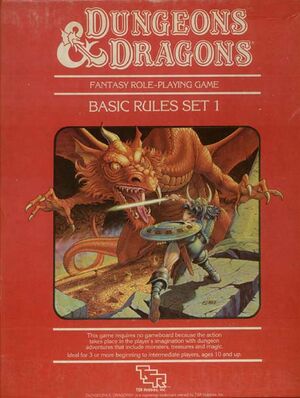
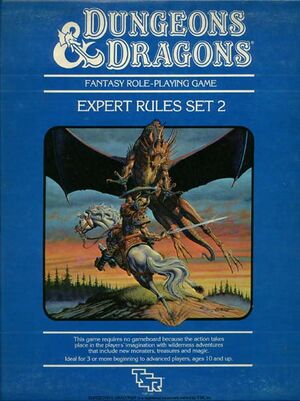
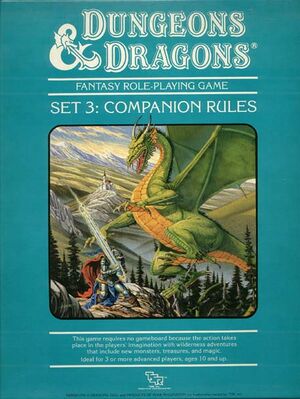
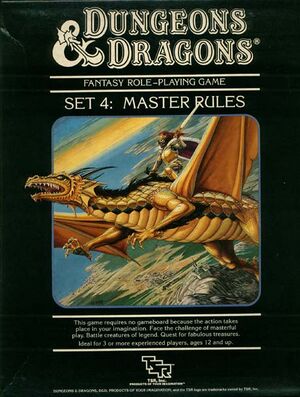
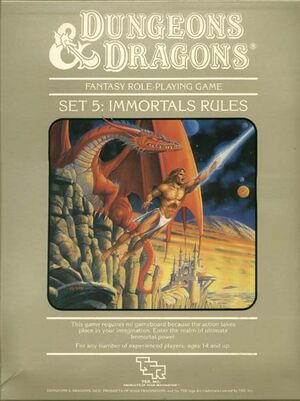
Basic Set
This had everything you needed for characters level 1-3. It included a rulebook and an adventure (Keep on the Borderlands). The later Mentzer version split the rulebook into a Players book and a DMs book (which were written as tutorials) and replaced the adventure with an unfinished one, where you try to avenge an NPC cleric Aleena on her murderer, a Magic-user named Bargle. It is a continuation of the Players' tutorial solo adventure (which was beneficial if you lacked players, and also inspired adventure gamebooks and invisible ink adventures like M1 Blizzard Pass). Some printings had 3 hole punch in the books to allow people to keep them in a binder easily. It also included a set of inexpensive dice that you colored in with a crayon. The books only printed material relevant for characters from levels 1-3 and so were much smaller than the average RPG book. This allowed them to be sold cheaply. Character classes included Fighter, Cleric, Magic-user, Thief, Dwarf (fighter with infra-vision and badass saving throws), an Elf (fighter/magic-user) or Halfling (proto-Ranger). Your alignment choices were Lawful, Neutral, or Chaotic.
Expert Set
This allowed you to advance from level 4 to level 14.
It came with another module (X1 Isle of Dread) and another set of dice.
It added a few more rules and more material relevant to characters of mid level.
Added combat rules for charging, using mount lances, or setting a spear to receive a charge. Introduced monsters with multiple attacks that could drain 2 levels per attack, instant kill poisons, and other things that made us hate our DM.
Moldvay wouldn't let demihumans (Elf, Dwarf, and Halfling) advance in level past this set, although by the end of their respective paths they had impressive saves and fair hit points. Mentzer relented and allowed their fighting ability improve (if your DM bought his Companion Set); so you weren't totally boned for playing subhuman filth.
Companion Set
Levels 15-25 were covered here. Has its own page now.
If you bought the box set you got another set of dice as well, say some people, but I never got any.
Higher level magic, more monsters and such (e.g., Beholder and Ghost). Rules for tricking out your Lawful Fighter as a Paladin, your Chaotic Fighter into a sort of anti-paladin named an Avenger, your Neutral Cleric into a Druid, etc. Demihumans get to progress in fighting ability but not along the same numerical level track, because reasons. The DMs' book included two mini adventures- a tournament featuring a knight named Sir Guy de Gax, and a pit-fighting adventure that forbade spellcasting.
New rules: running your own settlements (and what happens when you Louis XVI at it); and the War Machine, for waaugh against your enemies (or rebels, if you're Louis XVI).
Master Set
Levels 26-36.
This was for super high level campaigns. We haven't deemed it worthy of its own page yet.
The largest and nastiest monsters, the most powerful spells. The players' book added about 20 overpowered polearms with pictures of every one, so you had no excuse for not knowing what a Lochaber Axe is. The "Roll to Hit" tables were extended out to show what was needed to hit AC -20 (of all things), and some of them had printing errors. Hope you packed your magical bonuses! There were rules for making a Thief into an Assassin, which you could then never play, for it was Evil (tm). Although some people can't find those rules in their copy, only finding "Headsmen" and "Thug" monster-type NPCs for the DM to use. There were epic quests to become the greatest of your class, including one called "the Polymath", where your Magic-User had to advance to level 36 in each of the other classes to become a 36/36/36/36 everything.
DM section: artifacts n' relix, taken from our real world, like the Armet of Wayland. The War Machine is expanded for sieges. The monsters bring in the lich at last; and introduce the awesome Nightshades. Cover's inside is a massive map of the Brun continent with rectangles around the places we've been: X1: the Isle of Dread, X4-5-10: Desert Nomads series, X11: Saga of the Shadow Lord, X6: Quagmire!, CM1: Test of the Warlords.
Box set came with another set of the cheap, easily destroyed Crayola Dice, unless you were me.
Immortals Set
For when levels mean precisely dick-all.
This has rules for gods. It has to, who else is going to stand up to you?
Another set of dice in this box, along with writeups on classical gods of mythology.
The Adventures
Frontloaded. The B series got at least 12 of these in the end. The X series went up to 13. By contrast CM went only to 9, and M got 5 and most of those were awful. Three Immortals modules (did anyone even play those?).
There was another M line, for single-player - Basic tier. Also an O line for one-on-one between the DM and player: eXpert level. The DA series for Blackmoor, also eXpert level: four published.
Basically most players didn't get their characters far past level 8, and TSR catered to that reality.
The Rules Cyclopedia by Allston, Schend, Pickens and Watry
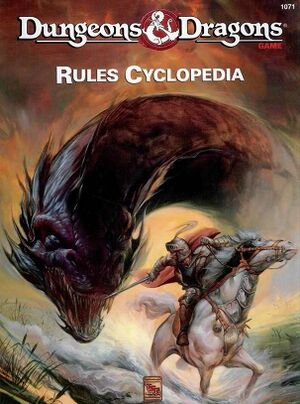
Rules Cyclopedia
In 1991, TSR was looking to wind down the Basic line in favor of the newest edition of Advanced Dungeons & Dragons but recognized the need to end it on a bit of a high note. As such, they took much of the rules from the Mentzer BECMI line and compile them into one book, the Rules Cyclopedia, with additional rules brought in from the various Gazetteers as they saw fit. While the RC focused mostly on the Basic to Master line of rules, it did touch on the Immortals rules but didn't go too deep with them, favoring instead to release an update to the Immortals rules in it's own box set called Wrath of the Immortals later on.
The Rules Cyclopedia was out of print for years and for a while would cost you quite a bit of money to buy (some copies were selling up for $300 dollars) but WotC, seeing some people begging for reprints of the older D&D works, put the Rules Cyclopedia up for Print-On-Demand in 2018, the POD version going for just $25 for a very good copy of it.